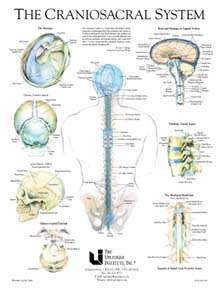
CranioSacral Therapy
CranioSacral Therapy (CST) is an approach to bodywork focusing on the semi-closed hydraulic system of cerebrospinal fluid that bathes the nervous system, its protective tissues, and the ligament like tissue where bones come together and move with respect to each other in the cranium. The movement associated with these anatomical structures provides the nervous system with nutrition and filters out toxins. There is a great deal of physical bodywork that can be done to get this system back into balance or into balance in the first place, as the case may be, but this really is the starting ground for CST. Going into deeper territory, the nervous system is used as a diagnostic tool for delving into energetic, emotional, and psychological issues that drive dysfunction that may occur on any level.
CST has been shown to be effective at treating a wide range of medical problems.
- Migraine Headaches
- Chronic Neck and Back Pain
- Motor-Coordination Impairments
- Colic
- Autism
- Central Nervous System Disorders
- Orthopedic Problems
- Traumatic Brain and Spinal Cord Injuries
- Scoliosis
- Infantile Disorders
- Learning Disabilities
- Chronic Fatigue
- Emotional Difficulties
- Stress and Tension-Related Problems
- Fibromyalgia and other Connective-Tissue Disorders
- Temporomandibular Joint Syndrome (TMJ)
- Neurovascular or Immune Disorders
- Post-Traumatic Stress Disorder
- Post-Surgical Dysfunction
I have studied CST I and II through Upledger's organization. While it provided me with a strong repertoire of tools and an anatomical understanding of the nervous system, it did not impact my approach to bodywork strongly until the beginning of 2007. For years, I had been experiencing a growing level of dysfunction on my right side particularly in my head. With the help of Kundalini Yoga, I changed the fact that I could not breathe through my nose but that did not get to the core issue. As things got worse, I noticed that I had less enervation to my right eye, the right side of my back was getting chronically tight, and my right leg tended to fall asleep when I would meditate. Near the beginning of 2007, I taught myself a technique based on yoga and bodyworking principles, with cranial therapy in mind, to affect my dural tube strongly in such a way that many of these symptoms radically changed for short durations of time. I have since found that Paul St. John has an excellent, more refined approach for dealing with this and that is what I now use. His organization at one time worked very closely with Upledger but since they split off, his cranial approach has differentiated by being structurally based (directly move bones into position) while the Upledger approach is physiologically based (synch with the fuild dynamics in the body and with very light pressure and intention correct dysfunction). I highly appreciate both approaches and will study further with both organizations.